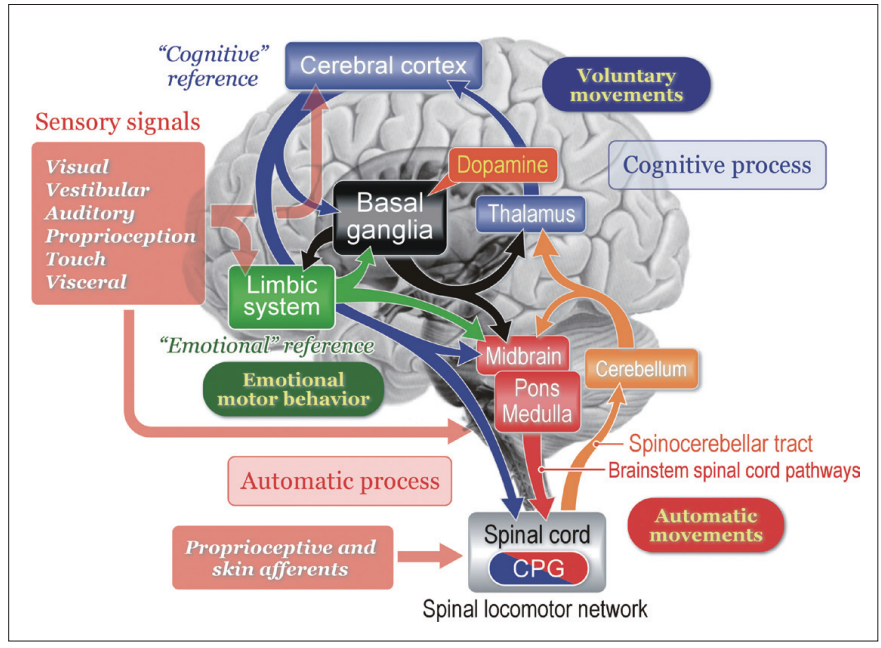
Higher-Level Gait Disorders (HLGD): a brief overview.
🚶🧠🦵
#Neuro #Neurotwitter #Neurology #Gait #Movement #Teaching
1/🧵
🚶🧠🦵
#Neuro #Neurotwitter #Neurology #Gait #Movement #Teaching
1/🧵
"It is likely possible to learn more about neurologic status from watching a patient walk than from any other single procedure, and observation of gait should always be part of a neurologic examination."
🧐🧠🥸
2/🧵
🧐🧠🥸
2/🧵
Gait is a sensory-motor function, which needs the adequate interaction between major systems for:
1⃣ Generating force
2⃣ Orientation in space
3⃣ Refine force
4⃣ Collate and interpret sensory information; select and modify motor programs
3/🧵
Gait in a "nutshell" (sort of) 👇
1⃣ Generating force
2⃣ Orientation in space
3⃣ Refine force
4⃣ Collate and interpret sensory information; select and modify motor programs
3/🧵
Gait in a "nutshell" (sort of) 👇

An easy-to-approach classification of these systems was published in 2013 and divided systems in:
1⃣ Lower
2⃣ Middle
3⃣ Higher
4/🧵
1⃣ Lower
2⃣ Middle
3⃣ Higher
4/🧵

Back to the topic, what are HLGD?
"Term used for locomotor and balance difficulties that cannot be explained by peripheral motor, sensory, pyramidal, cerebellar or basal ganglia lesions."
🧐🤔
5/🧵
"Term used for locomotor and balance difficulties that cannot be explained by peripheral motor, sensory, pyramidal, cerebellar or basal ganglia lesions."
🧐🤔
5/🧵
There are a multitude of terms which are part of HLGD
🥇 Gait apraxia
🥈 Frontal ataxia
🥉 Marche a petits pas
🍀 Lower-half parkinsonism/vascular parkinsonism (VaP)?*
*Most of these patients do not have VaP, but Leukoaraiosis-associated HLGD
6/🧵
🥇 Gait apraxia
🥈 Frontal ataxia
🥉 Marche a petits pas
🍀 Lower-half parkinsonism/vascular parkinsonism (VaP)?*
*Most of these patients do not have VaP, but Leukoaraiosis-associated HLGD
6/🧵
*For more information on what IS and what is NOT VaP I suggest the following articles by the amazing @AlbertoEspay
7/🧵


7/🧵



Clinical features 🏥
1⃣ Anterior/frontal HLGD
- Most Fx
- Freezing of the gait (FOG)
- Small Steps
- Disequilibrium
8/🧵
1⃣ Anterior/frontal HLGD
- Most Fx
- Freezing of the gait (FOG)
- Small Steps
- Disequilibrium
8/🧵

Clinical features🏥
2⃣ Posterior HLGD
- Abnormalities in the spatial real perception
- The sense of postural vertical may be disturbed
- Distorsions of enviroment and body maps are present
9/🧵
2⃣ Posterior HLGD
- Abnormalities in the spatial real perception
- The sense of postural vertical may be disturbed
- Distorsions of enviroment and body maps are present
9/🧵

What about Gait Apraxia? Adequate term?🧐
- Limb apraxia, not associated with gait and balance dysfx 🤔
- Limb apraxia 🟰 dominant parietal lesions
- HLGD/Gait apraxia most fx associated with bilateral medial frontal lesions 🧠
Apraxia and Gait Apraxia not same concepts
10/🧵
- Limb apraxia, not associated with gait and balance dysfx 🤔
- Limb apraxia 🟰 dominant parietal lesions
- HLGD/Gait apraxia most fx associated with bilateral medial frontal lesions 🧠
Apraxia and Gait Apraxia not same concepts
10/🧵
🚨 Basic Balance-locomotor circuits
1⃣ Shaded structures and connections are "hypothetically" affected in anterior or frontal HLGD
2⃣ The parietal, temporal and occipital lobes are hypothetically responsible for posterior HLGD
11/🧵
1⃣ Shaded structures and connections are "hypothetically" affected in anterior or frontal HLGD
2⃣ The parietal, temporal and occipital lobes are hypothetically responsible for posterior HLGD
11/🧵

HLGD can be one of the most difficult entities to understand and evaluate. This 🧵is based on a great paper by Nutt J, MD and serves as a brief intro to these disorders.
Let's not forget that HLGD are syndromes and an accurate evaluation may lead to the final diagnosis.
12/12
Let's not forget that HLGD are syndromes and an accurate evaluation may lead to the final diagnosis.
12/12

Sources:
1.- Mov Disord. 2013 Sep 15;28(11):1560-5.
doi: 10.1002/mds.25673.
2.- Campbell W. DeJong’s The Neurologic Examination. 8th Edition,2019.
3.- J Mov Disord. 2017 Jan;10(1):1-17.
doi: 10.14802/jmd.16062
4.- Mov Disord. 2015 Jun;30(7):886-94.
doi: 10.1002/mds.26263.
1.- Mov Disord. 2013 Sep 15;28(11):1560-5.
doi: 10.1002/mds.25673.
2.- Campbell W. DeJong’s The Neurologic Examination. 8th Edition,2019.
3.- J Mov Disord. 2017 Jan;10(1):1-17.
doi: 10.14802/jmd.16062
4.- Mov Disord. 2015 Jun;30(7):886-94.
doi: 10.1002/mds.26263.
More sources:
5.- Parkinsonism Relat Disord. 2022 Jan;94:132-134.
doi: 10.1016/j.parkreldis.2021.12.008.
6.- Arq Neuropsiquiatr. 2022 May;80(5 Suppl 1):42-52. doi: 10.1590/0004-282X-ANP-2022-S118.
5.- Parkinsonism Relat Disord. 2022 Jan;94:132-134.
doi: 10.1016/j.parkreldis.2021.12.008.
6.- Arq Neuropsiquiatr. 2022 May;80(5 Suppl 1):42-52. doi: 10.1590/0004-282X-ANP-2022-S118.
More and more sources:
7.- Continuum (Minneap Minn). 2022 Jun 1;28(3):750-780. doi: 10.1212/CON.0000000000001124.
8.- Phys Ther. 2003 Dec;83(12):1119-25
7.- Continuum (Minneap Minn). 2022 Jun 1;28(3):750-780. doi: 10.1212/CON.0000000000001124.
8.- Phys Ther. 2003 Dec;83(12):1119-25
• • •
Missing some Tweet in this thread? You can try to
force a refresh
















